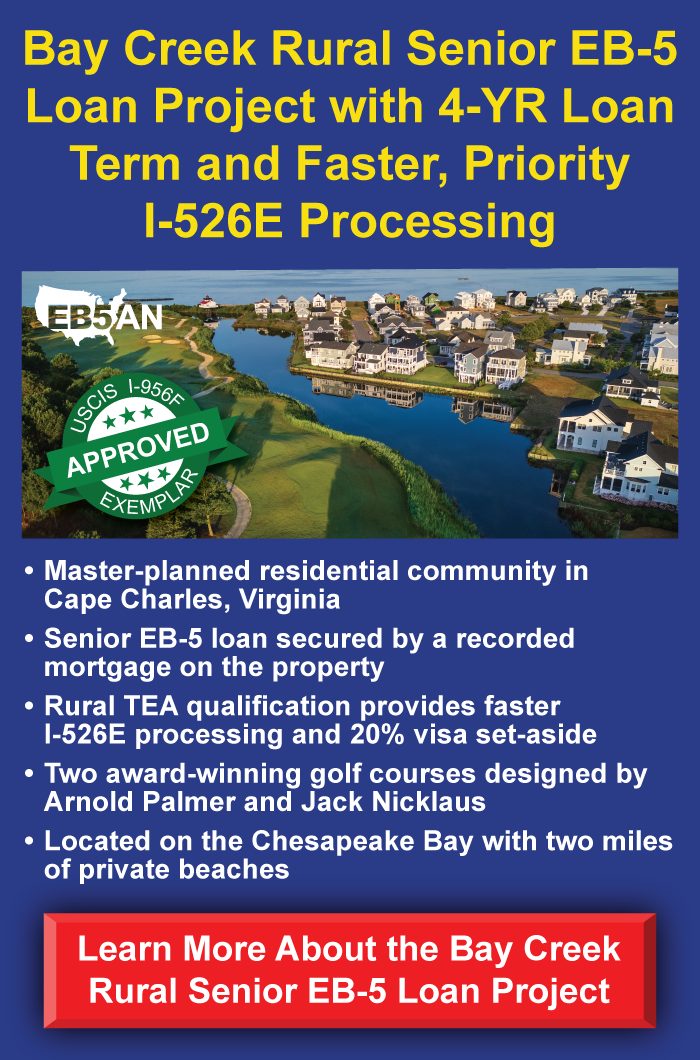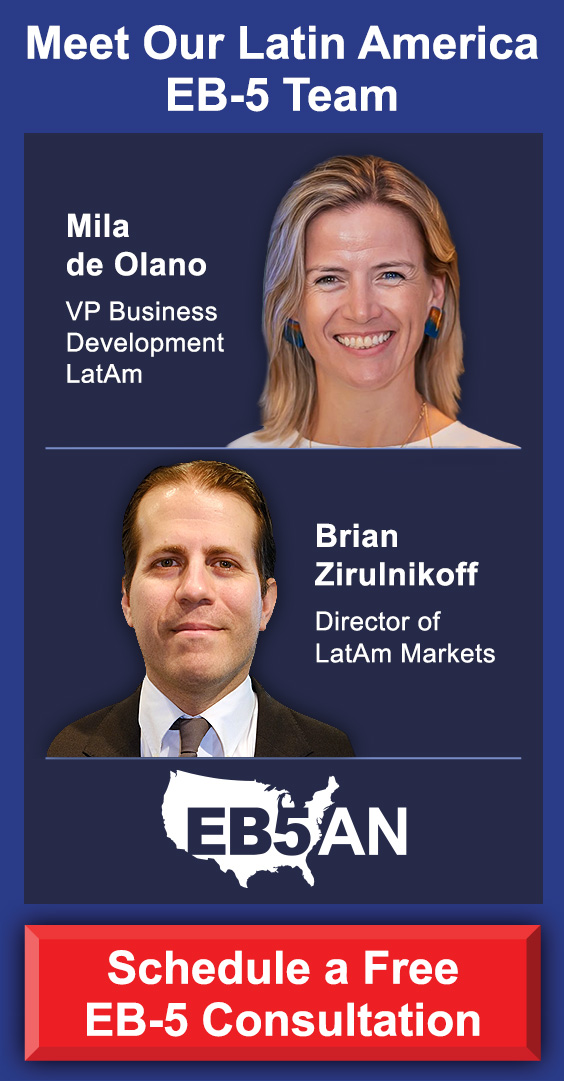The long legal dispute over how long post-RIA EB-5 investors must keep their money “at risk” has reached a decisive turning point—and investors in high-quality, shorter-duration urban projects are the big winners. A federal court has effectively cleared the path for USCIS to finalize rules that align with its current interpretation: a two-year sustainment period that runs from when the full investment is made and made available to the job-creating entity (JCE), not from the start of conditional residence.
In practical terms, this keeps the door open for shorter, predictable investment timelines, particularly in high-quality urban projects.
That’s exactly the model EB5AN used when it structured the ONE (Tampa) and Boynton Beach urban projects around the updated guidance—with the goal of combining immigration success with a faster repayment for investors.
The investors in ONE Tampa and Boynton are now on track to receive their funds back as early as 2028, regardless of the timing of their immigration adjudications. Some have already started receiving I-526E and Green Card approvals, enjoying the benefits of living in the United States—potentially, with capital repayment in as little as three to four years.
For investors seeking similar projects today, Terra Ceia—a USCIS-approved urban EB-5 project—offers substantially the same terms with a two-year sustainment framework.
In this article, we’ll examine the latest developments in the legal case against USCIS, how this affects investment timelines and redeployment risk, and how EB5AN’s urban projects like Terra Ceia offer both financial and immigration safety.
What the Court’s Ruling Means for EB-5 Investors
EB5AN’s Urban Projects Benefit From the Shorter Investment Period
Terra Ceia: EB5AN’s Latest Urban Project with a Short Investment Period
Investors in Urban EB-5 Projects Benefit From the Court’s Action—Consider a Short-Term Investment for Fast Repayment
What the Court’s Ruling Means for EB-5 Investors
In October 2023, USCIS announced that EB-5 investors only need to keep their capital invested for two years from the date it is first deployed, replacing the older “conditional residency” sustainment requirement. Then, on March 29, 2024, IIUSA, an EB-5 trade association, filed a lawsuit arguing that USCIS had overstepped by making this change without the notice-and-comment rulemaking required by the Administrative Procedure Act (APA), and pushed instead for a longer, five-year sustainment period.
But on July 29, 2025, Judge Ana C. Reyes of the U.S. District Court for the District of Columbia issued an order in the IIUSA v. DHS/USCIS litigation. Two takeaways matter most.
First, the court recognized that Congress indeed changed the EB-5 statute in the RIA; investors’ funds are “expected to remain invested for not less than 2 years,” a clear break from the pre-RIA era in which sustainment was tied to the two years of conditional permanent residence. Second, USCIS is moving forward with formal rulemaking and has indicated it will publish a Notice of Proposed Rulemaking (NPRM) in November 2025. While that process unfolds, USCIS’s current guidance remains in place.
This strongly supports USCIS’S October 2023 guidance, which states that the two-year period runs from when the full qualifying amount is invested in the new commercial enterprise (NCE) and placed “at risk,” including being made available to the JCE—not from the start of conditional residence. That interpretation is what the industry has relied on for nearly two years, and the court’s order leaves it in place while the notice-and-comment process proceeds.
While many pre-RIA investors had their funds invested for many years due to immigration delays, and had to rely on redeployment, the new policies are much more beneficial for investors. (For more information on EB-5 redeployment and the potential risks, see this article.)
A two-year sustainment period that starts at investment can align with shorter-duration EB-5 projects. If the project generates the required EB-5 jobs and is financially positioned to repay, investors may receive their principal significantly earlier than under the previous policy—without waiting for their conditional residence period to end.
In practice, this translates to cleaner investment timelines, less redeployment risk, and better capital discipline. Projects can match EB-5 investment periods with construction schedules, sales milestones, and refinancing events instead of being warped by variables in the immigration queue.
This is excellent news for EB-5 investors who chose short-term projects, including EB5AN’s own urban projects.
EB5AN’s Urban Projects Benefit From the Shorter Investment Period
Following the 2023 guidance, EB5AN moved quickly to design urban projects that matched a two-year sustainment period measured from when funds are made available to the JCE—without sacrificing the familiar safety features investors expect from us. ONE Tampa and Boynton Beach are two outstanding examples. Each of these urban projects was structured with a defined deployment schedule, ample job-creation cushions, third-party fund administration, and a short-term repayment.
Just as important, both offerings were structured to minimize redeployment risk by narrowing the gap between the sustainment window and the project’s natural exit or refinance. Put simply, the financial reality of each project was aligned to the new policy reality so investor capital could return on schedule once USCIS requirements were satisfied and the projects were positioned to repay.
What has been the result of our structuring these two short-term urban projects, following USCIS’s new policy on the sustainment period?
We are pleased to report that investors in ONE Tampa and Boynton Beach have already begun to receive I-526E approvals and their conditional Green Cards—and could get their funds repaid as early as 2028. Because the sustainment requirement is not tied to conditional permanent residence, a visa backlog or a longer-than-expected I-526E adjudication will not force the capital to sit in redeployment.
If a project has met job creation and is financially ready to repay after the two-year at-risk window, capital can return even while an investor’s USCIS case is still being processed.
In some cases, our investors will be able to both receive their initial Green Cards and get their funds back in a total of only 3 or 4 years!
And these fast immigration and financial benefits did not mean we lowered our standards of quality. ONE Tampa, an under-construction luxury condominium tower, was designed as a secured loan with a repayment guaranty from a well-capitalized, diversified parent company of the Kolter Group, and it benefitted from strong presales. The job-creation forecast—approximately 2,966 qualifying jobs—far exceeds what is needed for all EB-5 investors, and a signed GMP with Moss & Associates helped mitigate cost-overrun risk.
EB5AN’s independent oversight and third-party fund administration (PRXY) add transparency on deployments and uses of proceeds, while the I-526E approval refund and job-creation guaranties strengthen investor protections within the program’s “at-risk” framework.
Boynton Beach follows the same blueprint in a different asset class: it will be a 276-unit rental apartment community for seniors. Boynton was also supported by a repayment guaranty from the Kolter Group and is expected to be managed by Greystar, one of the largest global leaders in multifamily property management. The project’s job-creation forecast—approximately 859 qualifying jobs—again provides a meaningful cushion over the minimum ten-jobs-per-investor threshold. As with ONE Tampa, EB5AN’s independence from the developer, the use of third-party fund administration, and the presence of approval refund and job-creation guaranties were key parts of the offering.
Terra Ceia: EB5AN’s Latest Urban Project with a Short Investment Period
While both ONE Tampa and Boynton are closed for investment, we are pleased to offer Terra Ceia, a new urban EB-5 project with a short 3-year loan term.
Terra Ceia Multifamily is a 276-unit, market-rate, surface-parked rental community in Palmetto, Florida. The EB-5 offering is structured as a secured loan with a repayment guaranty from a diversified and well-capitalized Kolter parent company. The loan term is only three years, offering a faster timeline to repayment compared to typical EB-5 projects. The project benefits from Manatee County’s record $2.9 billion infrastructure budget, and the three-mile trade area is projected to grow 77% by 2028, ensuring long-term housing demand. The property is expected to be managed by Greystar.
Why Terra Ceia (Loan) is a Compelling Urban Project
Like ONE Tampa and Boynton, Terra Ceia is being developed by the Kolter Group. Safeguards include an I-526E approval refund guaranty, a Kolter job-creation spend guaranty, independent EB-5 oversight by EB5AN, and third-party fund administration by PRXY Fund Services. Job creation is projected at 640, comfortably above the 560 required.
Importantly, Terra Ceia qualifies as an urban targeted employment area (TEA), allowing investors to participate with the $800,000 minimum and access to set-aside reserved visas.
TEA designation provides substantial advantages for EB-5 investors. An urban TEA is defined by unemployment levels of at least 150% of the national average across the project tract and adjacent tracts. TEA designation reduces the investment threshold to $800,000 and grants access to reserved visas. Under the EB-5 Reform and Integrity Act of 2022, 32% of all EB-5 visas are reserved, with 10% specifically for urban TEAs.
By investing in a TEA project, Chinese and Indian investors living in the U.S. can adjust status immediately and avoid months or years of additional delays for their Green Cards.
With a track record of $30 billion in completed projects and more than 27,000 delivered units, Kolter has borrowed billions over its history and has never failed to repay a loan. Every EB-5 project Kolter has sponsored has either already repaid investors or remains in good standing.
These combined features—secured loan structure, short loan term, high-growth location, experienced developer, strong property management, significant job creation, and independent oversight—position Terra Ceia Multifamily as one of the strongest and safest urban EB-5 opportunities available today.
Investors in Urban EB-5 Projects Benefit From the Court’s Action—Consider a Short-Term Investment for Fast Repayment
The court’s support of a two-year sustainment period—and USCIS’s move to formalize it—simply validates the approach already used in ONE (Tampa) and Boynton Beach. When a project is built around a defined two-year at-risk window, meets or exceeds job-creation requirements, and is capitalized to repay on business milestones rather than immigration approvals, investors are not forced into redeployment while waiting for their conditional residencies to end.
That is why investors in our urban projects are on track for a fast repayment.
For investors seeking that same project type today today, Terra Ceia extends the same principles in a USCIS-approved urban EB-5 project with a short loan term, a secured structure, third-party fund administration, and material job-creation cushions—paired with a developer that has a long, flawless record of repaying senior loans. By matching the EB-5 timeline to construction, lease-up, and refinance milestones, Terra Ceia aims to deliver the same predictability that made ONE and Boynton compelling.
The bottom line: a two-year sustainment period measured from deployment brings EB-5 offerings in line with real-world project cycles and investor goals.
If your goal is a shorter, clearer path to both immigration outcomes and repayment, now is the time to consider short-term urban projects like Terra Ceia to secure your Green Cards and a fast repayment—in potentially only a few short years.
For more information, schedule a free consultation with EB5AN.







